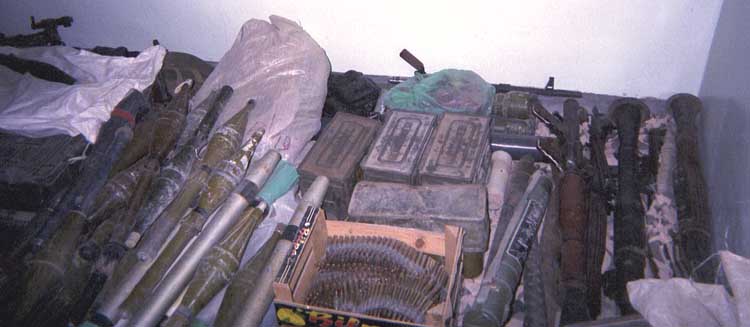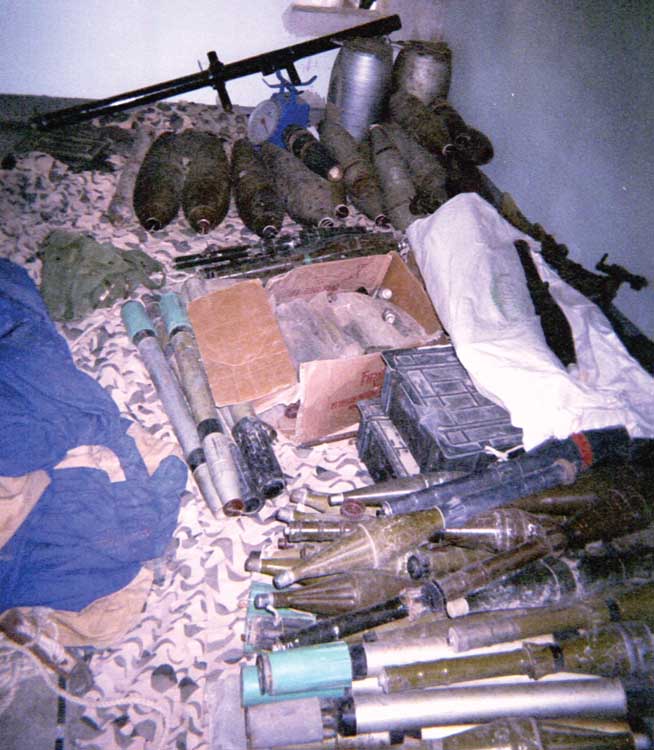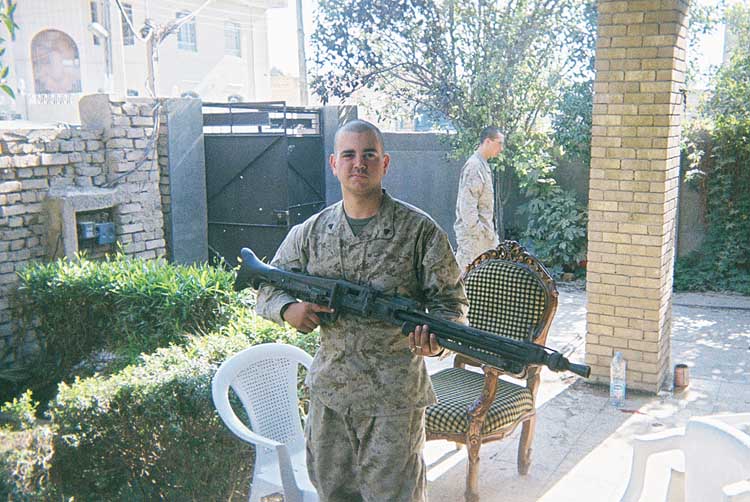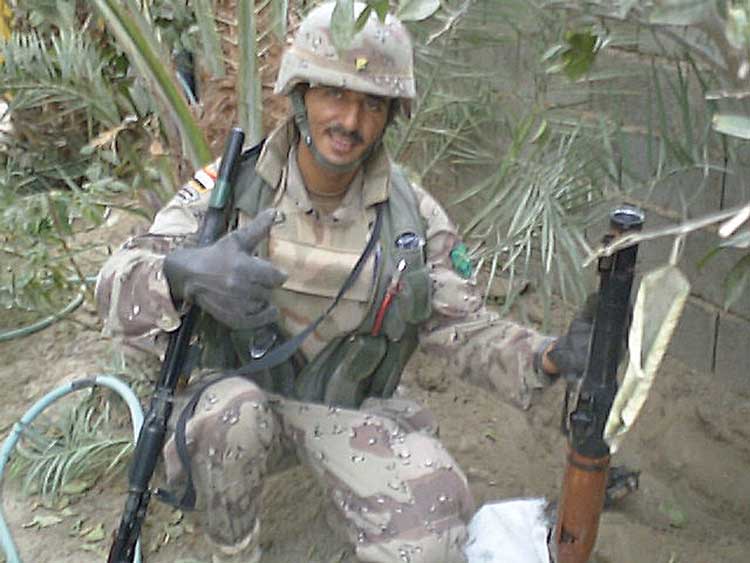The author taking a quick pause during a lull in the fighting to have a photo snapped with the Bren gun he found and was about to dispose of under a passing tank.
Prologue
In November 2004, the United States Marine Corps rewrote the manuals on urbanized warfare as they battled the insurgency in Fallujah. The Battle of Fallujah was known as Operation Phantom Fury/Al-Fajr (the dawn) and took place from November 2004-December 2005. It would cost 195 American lives and take the lives of thousands of enemy insurgents. The Battle of Fallujah would go on to be described as the bloodiest urban battle since Hue City, Vietnam in 1968.

The insurgency that occupied Fallujah prior to the 2004 invasion was comprised of two types of fighters. One type was well trained foreign fighters in Iraqi to wage Jihad on America and the second was die-hard Iraqi insurgents who viewed the Americans as invaders and wanted them out of Iraq. These forces were vastly different; however they shared several things in common. They were both willing to fight to the death and they were both extremely well armed. Although weapons are common on any battlefield, after carefully analyzing the firearms utilized by the insurgency in Fallujah one would have to be curious as to the origins of some.

In April of 2004, the U.S. Military acting in response to the killing and mutilation of several military contractors decided to launch an invasion on the city of Fallujah and root out the insurgency there. The U.S. Military launched Operation Vigilant Resolve but ran into stiff resistance almost immediately. The U.S. Marines initial invasion into Fallujah caused many casualties on both sides but also began inflicting collateral damage to the civilian populace and started crumbling Fallujah’s infrastructure. Due to concern over collateral damage, the U.S. troops broke engagement and exited the city. Upon exit, the U.S. forces cordoned the city, laying it under siege. Security check points were set up and manned around the city’s perimeter enabling patrols of the city’s outskirts. These forces were also able to control traffic flow into and out of the city and gave the U.S. Military the opportunity to search vehicles and personnel. The use of fortified patrol bases around the city worked well in restricting the movements of insurgents outside the city limits; however inside the city insurgents roamed freely as no U.S. presence was maintained inside Fallujah.
Inside Fallujah the insurgency was free to launch mortar and rocket attacks at the troops stationed at the positions around the city. The insurgents also regularly conducted sniper attacks, sprung ambushes on supply convoys and harassed the day to day operations around the city with impunity. This deteriorating security situation lasted for nearly 7 months until November of 2004 when the U.S. Military decided to re-attack the insurgent stronghold. Since the April 2004 withdrawal of U.S. Forces from within the cities limits, Fallujah was left completely open to the insurgents and maintained no U.S. presence within the city. This gave the opposition time to prepare, draw battle plans, establish caches, tunnel, plant IEDs within the infrastructure (cemented into the sidewalks) and allow their supply chain to flood the market with explosives, weapons and ammo. The U.S. Marines assault on Fallujah was swift, brutal and deadly. U.S. Forces took hundreds of casualties, killed thousands of insurgents, destroyed much of Fallujah’s infrastructure and encountered weapons very seldom seen on today’s battlefields. Videos shot by insurgents prior to the U.S. invasion of Fallujah depicts insurgents manning checkpoints with PKMs, RPGs, SA-7 and SA-14 anti-aircraft missiles and other types of ComBloc battlefield weaponry. The true quantities and vast types of firearms available stifled even the most senior officials when the battle subsided and reports were taken.
Weapons Supply Chain
The insurgency in Iraq drew weapons and equipment from many sources. After Sadaam Hussein’s government was toppled his arsenals were looted by the populace and weaponry began to flood the streets and markets. Certain areas of Fallujah became impromptu arms bazaars selling these weapons off to insurgents and populace alike.

Many of the foreign fighters entering Iraq by car or train from Syria to fight against the U.S. passed through Fallujah. They frequently stopped to drop off or pick up weaponry in the process. Another source was due to the Iran-Iraq war and the first U.S.-Iraq war. Many weapons remained in the hands of the civilian populace and were easily sold for high prices to the insurgency. These were the insurgent’s easiest route to securing arms to fight the coalition forces.
Some weapons were smuggled in from Syria and other Arab nations and also usually found their way to areas such as Ramadi or Fallujah as they were along the route to Baghdad and were hotbeds of insurgent activity. Black market arms dealers were prevalent in Iraq. The coalition forces on occasion were tipped off to be on the alert for vehicles traveling that were occupied by alleged arms dealers traversing the countryside brokering illicit deals with Al-Qaeda in Iraq and the Insurgency. Another unfortunate source of insurgent arms was via the Iraqi Military and Police. Many times after the U.S. delivered new shipments of arms to local police or military units a group of insurgents would raid the armory and take them. Sometimes the insurgents would drop in for chai and get help from the local authorities loading up the new guns as they were often in cahoots.
Although the Kalashnikov was the most prevalent firearm on the battlefield, many other firearms were encountered. Like most Islamic Insurgencies the main armaments utilized were the AK-47/AKM, FN FAL rifles, G-3 rifles, SVD sniper rifles, RPK light machine guns, PKM General Purpose MGs, RPG-7 rocket assisted grenade launchers and SPG-9 recoilless rifles as well as the DSHK heavy MG and ZU-23-2 anti-aircraft gun. Most of these weapons were of various origins that where common for their type.
Most of the hardware was derived from Russia, Bulgaria, Yugoslavia, China, East Germany, Egypt, Romania and Iraq’s Tabuk Armory. The aforementioned firepower was integrated into Sadaam’s military ranks via legitimate sale and eventually ended up on the streets due to the toppling of his government and subsequent looting. Often times these weapons can be easily distinguished by arsenal markings, safety selector markings and by accessories such as the plastic pistol grip and grenade launching sites commonly seen on Iraqi and Yugo AKs.

Rarely encountered yet relished when they were confiscated were unlicensed Iranian copies of the MP5 submachine gun. These firearms were found on several dead insurgents not possessing identification so it remains unclear if they were operatives from Iran or simply utilizing weaponry left over from the Iran-Iraq war. As most firepower recovered from the enemy was placed in massive piles and destroyed, troops often times adopted them for personal use utilizing issued 9x19mm cartridges from their Berretta M9 (Model 92) to fill the magazines. The compact size of the retractable stock version MP5 encountered enabled troops to conduct close quarters battle with a combat proven weapons system without telegraphing the longer barrel of the M16A4 rifles they were issued past doorways and also gave them a fully automatic capability as opposed to the standard 3-round burst. Also recovered were several unlicensed Iranian copies of the G3 rifle. The markings were unique and very rarely encountered but were most certainly those of the Islamic Republic of Iran.

These rifles were often times recovered from dead Chechen foreign fighters who were also equipped with modern tactical vest, body armor and optics. They were often times hopped up on pain killers and had pre-applied tourniquets on their limbs.
Chechens could be easily distinguished by their lighter skin tone, lighter hair color, advanced equipment, Chechen literature and terrorist manuals they carried and by the amount of casualties they inflicted on U.S. forces in the ensuing battle to kill them. Overly accurate Chechen snipers utilizing Iranian G3 clones over the Draganov sniper system seemed to be commonplace on the battlefield of Fallujah.
Old Workhorses still in Action,
Some of the rare and exotic weaponry that was located throughout the battlefield of Fallujah had a more unique history. Firearms such as the British Sterling SMG, Soviet PPSh-41 SMG or the British Bren gun were often encountered in caches as opposed to being utilized in active combat by insurgents. In one specific instance, however, a general purpose machine gun was utilized to pin down U.S. troops advancing towards a row of shops. After Marines overran the position they were surprised that the enemy’s machine gun looked like a “mini Browning M2HB.” The Marines were even more surprised when they could read the markings on the firearms and determine it was of U.S. origin and being used against them. It was a U.S. Browning M1919A4 .30 caliber machine gun. It was clearly very old, possibly from Korea or WWII era. Insurgents are known to utilize any firearms they can find – however, where did such antique firearms come from? After some careful digging it was established that several of the WWII weapons we encountered seemed to have derived from the post-invasion looting of Baghdad’s museums. Shortly after their looting they were enlisted into the insurgent’s arsenal via a high ticket price on the Iraqi black market.
Pistols were also readily available on the battlefield. Browning Hi-Power, CZ 75, Makarov, Tokarov, Glock 19, Walther P99, Colt 1911, Webley and Zastava revolvers and local Iraqi Tariq pistols were everywhere. Tariq pistols were Iraqi copies of the Beretta 52/Helwan pistols scrawled with Arabic writing and with a gold inlayed coin in the pistol grips. Pistols were usually found in caches as were homemade suppressors, however on occasion a pistol would be found on an insurgent, usually signifying a position of authority. CZ Skorpians were also a commonly encountered SMG but due to the small 7.65 caliber round it was never adapted for use by troops as was the MP5s, Sterlings, and PPSh-41s.
Fallujah was a battle fought much differently from other battles in the war. U.S. troops didn’t drive headlong into city’s centers and raise the flag as was done in Baghdad. Fallujah was fought room by room, house by house, block by block throughout the entire city. Enemies were encountered sometimes one or two at a time and others in groups of 25 or 30 and always heavily armed. Troops were unsure if enemies were in the next room, the next house or on the next block. This situation made the battle a very tense one. Until the battle ended and the city was searched, the US forces had no idea the arsenal that was hidden behind closed doors awaiting them.
Aftermath
After the city was seized by U.S. forces the daunting process of back clearing homes, conducting counter insurgency operations and attempting to retrieve and render inoperable all enemy hardware became the Marine mission.
Piles of firearms, mortars, rocket launchers, ammunition, grenades, explosives, and equipment lay around the base for months. These firearms were eventually lined up and crushed by tanks or burned. Surprisingly, even the crushing strength of an M1 Abrahams tank on weapons on concrete wouldn’t always render Kalashnikovs inoperable. The explosives and ammunition were placed in a large pit and controlled detonated by U.S. Explosive Ordinance Disposal units. Certain trophy pieces such as a Browning 12 gage with gold inlay, gold and chrome Kalashnikovs and custom Tariq pistols were spared for use in museums back in the states or for units to utilize as trophies for their barracks back home.
In the end, the Marines and Corpsman who took part in the battle saw the world’s most raw firepower being utilized at its finest and still managed to reckon with their enemies. All combatants learned firsthand more about firepower than they could have ever imagined: from the capabilities, usage and nomenclature of the enemies weapons to their strengths and weaknesses. The Battle of Fallujah was not only a tremendous battle and tactical feat for those involved it also became a university on foreign small arms.

(About the author: Jonathan M. Cuney is a former U.S. Marine Sergeant and combat wounded veteran of the Battle of Fallujah. He is the recipient of the Purple Heart, Combat Action Ribbon, Conspicuous Service Cross, Conspicuous Service Star and nearly a half dozen other medals and accommodations. He served as the Threat Weapons Non Commissioned Officer (NCO) for Kilo Company, 3rd Battalion, 5th Marines of the 1st Marine Division. Sgt. Cuney many times utilized his expertise to assist in identifying enemy weapon systems both captured and in use by the enemy during combat. This gave the troops he fought alongside the knowledge they needed to recognize the enemy’s capabilities (range, rounds per min, etc.). It also helped to render the enemies firearms inoperable as they continued to push on in their advance during battle.)
| This article first appeared in Small Arms Review V15N1 (October 2011) |











